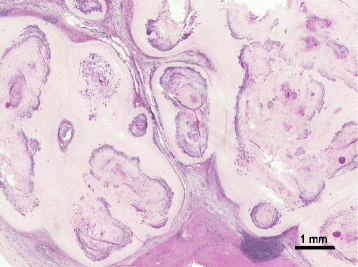Capillaria hepatica (Calodium hepaticum) infection in a horse: a case report
- PMID: 29221457
- PMCID: PMC5723056
- DOI: 10.1186/s12917-017-1301-3
Capillaria hepatica (Calodium hepaticum) infection in a horse: a case report
Abstract
Background: Capillaria hepatica is a zoonotic parasite in humans and animals and has a worldwide distribution. However, infections in mammals apart from rodents, which are natural hosts of the parasite, have rarely been reported. This report describes the first known case of C. hepatica infection in a horse in Japan.
Case presentation: A 3-year-old filly without clinical signs was presented at a slaughterhouse in Japan. Gross examination revealed white to tan nodules 0.5 to 1.5 cm in diameter in the parenchyma of the liver. Histologically, the nodules had mature fibrous capsules and consisted of multifocal to coalescing granulomatous inflammations with numerous nematode eggs. The eggs were barrel shaped with an opercular plug on each end and double-layered shells; these findings are consistent with the features of C. hepatica eggs.
Conclusions: To our knowledge, this is the first case of C. hepatica infection in a horse in Japan. The pathological findings confirmed the presence of this pathogen in this part of the world, and they highlight the importance of this nematode in the differential diagnosis of hepatic granulomatous lesions in horses.
Keywords: Capillaria hepatica; Hepatic capillariasis; Horse.
Conflict of interest statement
Ethics approval and consent to participate
The Japan Racing Association is a sporting authority; we collected clinical samples and performed the study as part of the Association’s regular disease-prevention activities. The study was approved by the Equine Research Institute of the Japan Racing Association.
Consent for publication
Not applicable.
Competing interests
The authors declare that they have no competing interests.
Publisher’s Note
Springer Nature remains neutral with regard to jurisdictional claims in published maps and institutional affiliations.
Figures


Similar articles
-
Hepatic Capillaria hepatica (Bancroft, 1893) infection in cat (Felis catus)-histopathological findings and first report from Iran.Parasitol Res. 2021 Apr;120(4):1489-1491. doi: 10.1007/s00436-021-07056-4. Epub 2021 Jan 22. Parasitol Res. 2021. PMID: 33479780
-
Case report of hepatic calodiosis in a rescued dog.Vet Parasitol Reg Stud Reports. 2023 Nov;46:100942. doi: 10.1016/j.vprsr.2023.100942. Epub 2023 Oct 27. Vet Parasitol Reg Stud Reports. 2023. PMID: 37935537
-
[Capillaria hepatica infection in rodents from Anning Prefecture of Yunnan Province and experimental research on host animals].Zhongguo Ji Sheng Chong Xue Yu Ji Sheng Chong Bing Za Zhi. 2013 Oct;31(5):367-71. Zhongguo Ji Sheng Chong Xue Yu Ji Sheng Chong Bing Za Zhi. 2013. PMID: 24818392 Chinese.
-
An overview of the host spectrum and distribution of Calodium hepaticum (syn. Capillaria hepatica): part 2-Mammalia (excluding Muroidea).Parasitol Res. 2014 Feb;113(2):641-51. doi: 10.1007/s00436-013-3692-9. Epub 2013 Nov 21. Parasitol Res. 2014. PMID: 24257974 Free PMC article. Review.
-
An overview of the host spectrum and distribution of Calodium hepaticum (syn. Capillaria hepatica): part 1-Muroidea.Parasitol Res. 2014 Feb;113(2):619-40. doi: 10.1007/s00436-013-3691-x. Epub 2013 Nov 19. Parasitol Res. 2014. PMID: 24248632 Free PMC article. Review.
Cited by
-
Histopathological evaluation of Capillaria hepatica (Bancroft, 1893) in Cricetomys gambianus (Waterhouse, 1840).J Parasit Dis. 2025 Mar;49(1):186-192. doi: 10.1007/s12639-024-01743-6. Epub 2024 Oct 5. J Parasit Dis. 2025. PMID: 39975617
-
Spurious infection by Calodium hepaticum (Bancroft, 1983) Moravec, 1982 and intestinal parasites in forest reserve dwellers in Western Brazilian Amazon.Rev Inst Med Trop Sao Paulo. 2022 Feb 2;64:e2. doi: 10.1590/S1678-9946202264002. eCollection 2022. Rev Inst Med Trop Sao Paulo. 2022. PMID: 35137896 Free PMC article.
-
Canine hepatic calodiosis with cirrhosis.J Parasit Dis. 2022 Sep;46(3):613-616. doi: 10.1007/s12639-022-01501-6. Epub 2022 Jun 4. J Parasit Dis. 2022. PMID: 36091291 Free PMC article.
-
Rats and their helminth parasites: Potential zoonosis threats of land use change in the northeastern sub-watersheds of Mount Makiling, Laguna, Philippines.Helminthologia. 2024 Apr 23;61(1):30-39. doi: 10.2478/helm-2024-0005. eCollection 2024 Mar. Helminthologia. 2024. PMID: 38659471 Free PMC article.
References
-
- Spratt DM, Singleton GR. Hepatic capillariasis. In: Samuel MW, Pybus JM, Kocan AA, editors. Parasitic diseases of wild mammals. USA: Wiley-Blackwell; 2008. pp. 365–379.
-
- Stalker M, Hayes M. Liver and biliary system. In: Maxie G, editor. Jubb, Kennedy, and Palmer’s pathology of domestic animals. Elsevier: St. Louis; 2016. pp. 258–352.
Publication types
MeSH terms
LinkOut - more resources
Full Text Sources
Other Literature Sources

